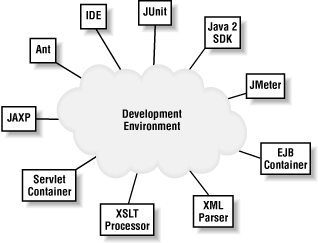Chapter 9. Development Environment, Testing, and Performance
This chapter provides an overview of many different technologies that comprise a typical Java and XSLT software development environment. Once the most commonly used tools are introduced, strategies for testing XSLT and tuning performance are presented. Instead of presenting specific performance benchmarks for various XSLT processors, this chapter’s focus is on effective programming techniques that should be applicable to a wide range of tools. XSLT is a very young technology, and tools are improving all the time.
Development Environment
Specialized, lightweight development tools have never been more important to Java developers. Commercial integrated development environments (IDEs) are now only one small piece of a larger suite of essential tools used by a majority of Java development projects. These build tools such as Ant, testing tools such as JUnit, and various XML parsers and XSLT processors. Figure 9-1 illustrates some of the tools found in a typical Java and XSLT development environment.

Figure 9-1. Common Java, XML, and XSLT tools
Although this is a typical development environment, it can be a large number of tools to keep track of. Table 9-1 summarizes how each of these tools is used.
Table 9-1. Tool overview
|
Tool |
Description |
|---|---|
|
Java 2 SDK |
The Java 2 software development kit, i.e., the JDK. |
|
Apache’s JMeter |
A stress-testing ... |
Get Java and XSLT now with the O’Reilly learning platform.
O’Reilly members experience books, live events, courses curated by job role, and more from O’Reilly and nearly 200 top publishers.

